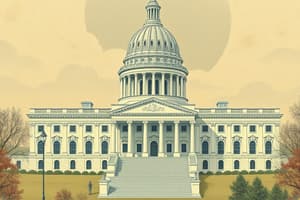Podcast
Questions and Answers
What is the primary role of the legislative branch of the U.S. government?
What is the primary role of the legislative branch of the U.S. government?
- Enforcing laws
- Interpreting laws
- Making laws (correct)
- Advising the president
What does 'bicameral' mean in the context of the U.S. Congress?
What does 'bicameral' mean in the context of the U.S. Congress?
- Having three branches
- Having a single house
- Having two houses (correct)
- Having multiple leaders
What was the result of the Great Compromise of 1787 in relation to Congress?
What was the result of the Great Compromise of 1787 in relation to Congress?
- Creation of a unicameral congress
- Creation of the executive branch
- Expansion of the House of Representatives
- Establishment of equal representation in the Senate (correct)
How long do members of the Senate serve?
How long do members of the Senate serve?
What specific powers does the Senate have in the U.S. government?
What specific powers does the Senate have in the U.S. government?
How many representatives serve in the House of Representatives?
How many representatives serve in the House of Representatives?
What are the qualifications for becoming a senator or representative according to the Constitution?
What are the qualifications for becoming a senator or representative according to the Constitution?
What unique responsibility does the House of Representatives have in the U.S. government?
What unique responsibility does the House of Representatives have in the U.S. government?
Flashcards are hidden until you start studying
Study Notes
- The legislative branch of the U.S. government, as presented in the video, consists of three branches: legislative, executive, and judicial
- The legislative branch is described in Article 1 of the Constitution, and its primary role is to make laws
- Congress, which leads the legislative branch, is bicameral, meaning it has two houses: the Senate and the House of Representatives
- The Senate and House were created to reconcile disputes between states regarding representation
- The Great Compromise of 1787 resulted in a bicameral congress, with the Senate based on equal representation (two senators per state) and the House based on proportional representation
- The Senate has 100 members, and senators serve six-year terms, while the House has 435 representatives, and representatives serve two-year terms
- The Constitution outlines specific qualifications for senators and representatives, including residency, age, and citizenship requirements
- The Senate and House share some powers, including making laws, but each has unique responsibilities: the Senate can approve or reject treaties and presidential nominations, while the House can introduce spending bills and select the president if necessary.
- The powers of congress, as outlined in the Constitution, include declaring war, making money, collecting taxes, and the elastic clause, which allows congress to make necessary laws to address new issues.
Studying That Suits You
Use AI to generate personalized quizzes and flashcards to suit your learning preferences.



